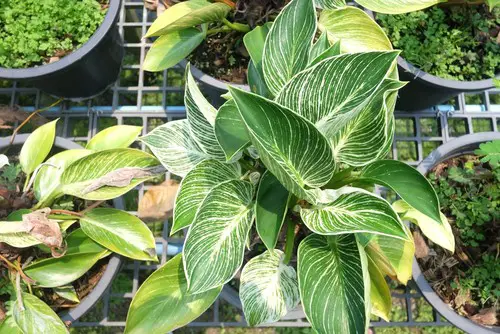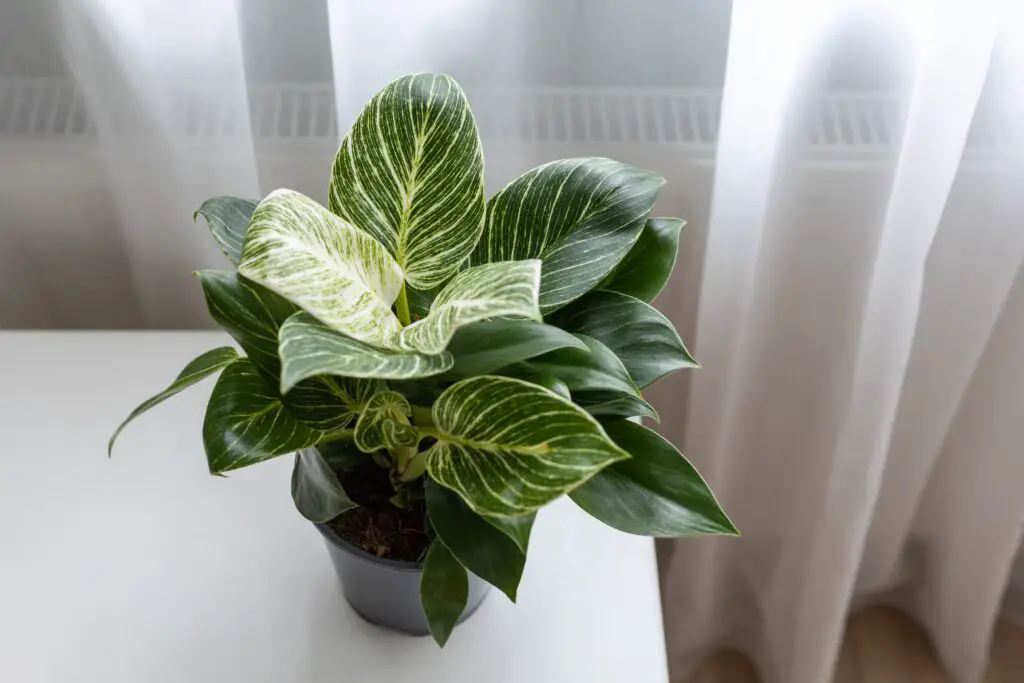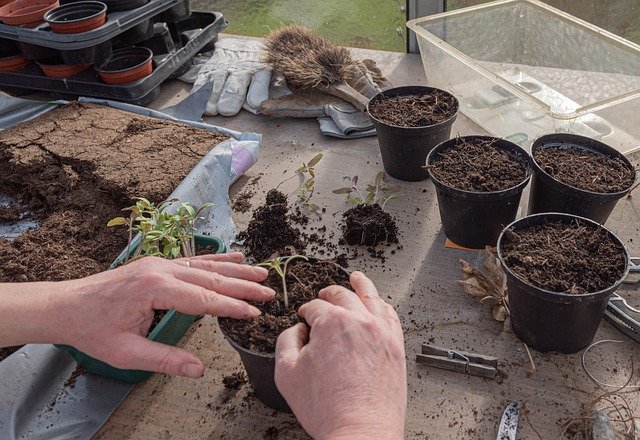Small brown spots on philodendron leaves can be a common issue for plant owners. These spots can appear for a variety of reasons and can be a sign of underlying problems that need to be addressed. Identifying the cause of the brown spots is crucial in order to effectively treat and prevent further damage to the plant.
There are several common causes of small brown spots on philodendron leaves. Overwatering, nutrient deficiencies, pests, diseases, and environmental factors such as light and temperature can all contribute to the appearance of brown spots.
Understanding the role of these factors in the health of the plant is important in order to properly care for it.
Proper care and treatment can help prevent further damage to the plant and promote healthy growth. This article will discuss the common causes of small brown spots on philodendron leaves, as well as treatment and prevention strategies to keep your plant healthy and thriving.
Key Takeaways
- Identifying the cause of small brown spots on philodendron leaves is crucial in order to properly treat and prevent further damage to the plant.
- Overwatering, nutrient deficiencies, pests, diseases, and environmental factors such as light and temperature can all contribute to the appearance of brown spots.
- Proper care and treatment, including addressing the underlying cause of the brown spots, can help promote healthy growth and prevent further damage to the plant.
Also see:
- Small Brown Spots on Orchid Leaves:
- Small Brown Spots on Monstera Leaves
- Rhododendron Leaves Turning Yellow with Brown Spots
Identifying Small Brown Spots on Philodendron Leaves

Philodendrons are popular houseplants known for their lush green foliage. However, like any other plant, they can develop brown spots on their leaves. Small brown spots on philodendron leaves can be caused by various factors, including leaf spot diseases, sunburn, pests, and more.
One of the most common causes of small brown spots on philodendron leaves is leaf spot diseases. These diseases can be caused by fungi, bacteria, or viruses and can result in small brown spots or lesions on the leaves.
Fungal leaf spot diseases are common in philodendrons and can be identified by the presence of circular or irregular brown spots on the leaves. Bacterial leaf spot diseases, on the other hand, can cause water-soaked lesions that turn brown over time.
Another possible cause of small brown spots on philodendron leaves is sunburn. Philodendrons are native to tropical regions and require bright, indirect light. When exposed to too much sunlight, the leaves can develop brown spots or patches, which is a type of leaf damage referred to as sunburn.
Pests can also cause small brown spots on philodendron leaves. Spider mites, for instance, can cause small brown spots on the leaves, which can eventually turn yellow or fall off. Thrips and mealybugs can also cause brown spots on philodendron leaves.
To identify small brown spots on philodendron leaves, it is essential to look for other symptoms as well. For instance, if the spots are caused by leaf spot diseases, they may be accompanied by yellowing or wilting of the leaves. If the spots are caused by pests, you may notice other signs such as webbing or insects on the plant.
Common Causes of Small Brown Spots
Philodendrons are beautiful plants that can add a touch of nature to any room. However, small brown spots on the leaves can be a common issue that many plant owners face. These spots can be caused by a variety of factors, including overwatering, pests, diseases, and environmental stressors.
One of the most common causes of small brown spots on philodendron leaves is overwatering. When a plant is overwatered, it can lead to root rot, which can cause the leaves to turn yellow and brown.
It is important to ensure that the plant is not sitting in water and that the soil has proper drainage. In addition, it is important to water the plant only when the top inch of soil is dry.
Another common cause of small brown spots on philodendron leaves is pests. Aphids and other insects can cause damage to the leaves, which can result in brown spots. Insecticidal soap, horticultural oil, and neem oil can be effective in treating these pests.
Fungal diseases can also cause small brown spots on philodendron leaves. Leaf spot disease is a common fungal infection that can cause small brown spots on the leaves. This disease can be treated with a fungicide and by ensuring that the plant has proper air circulation and humidity levels.
Environmental stressors, such as excessive sunlight and low humidity, can also cause small brown spots on philodendron leaves.
It is important to ensure that the plant is not exposed to direct sunlight and that the humidity level is around 50%. In addition, it is important to ensure that the plant is not exposed to cold drafts during the winter months.
Role of Light and Temperature

Philodendrons are tropical plants that thrive in medium to low light settings. Too much direct sunlight can cause brown spots on the leaves, which is referred to as sunburn.
It is a type of leaf damage that can occur when plants are not properly protected from the sun. Philodendrons can also develop brown spots if they are exposed to excessive artificial light.
During the winter months, when there is less natural light, it is important to provide adequate artificial light to prevent brown spots from developing on the leaves.
Philodendrons can also develop brown spots if they are exposed to temperatures that are too low or too high. They prefer temperatures between 60-75°F (15-24°C) and can be sensitive to sudden temperature changes.
It is important to find the right balance between direct and indirect light for philodendrons. Direct light can cause brown spots on the leaves, but too little light can also be harmful to the plant. Philodendrons can also adapt to different levels of light, but sudden changes in light can cause stress and lead to brown spots.
Watering and Soil Conditions
Philodendrons require a well-draining soil mix that retains moisture without becoming waterlogged. Overwatering can lead to root rot, which can cause small brown spots on the leaves. It is important to ensure proper drainage in the pot and to avoid leaving the plant in standing water.
The frequency of watering depends on several factors, including the size of the pot, the type of soil, and the humidity levels in the environment. It is recommended to water the plant when the top inch of soil feels dry to the touch, rather than on a strict watering schedule.
The quality of the water used for watering can also affect the health of the plant. Tap water may contain chemicals and minerals that can build up in the soil over time and damage the roots. Using distilled or filtered water can help prevent this issue.
In addition to proper watering, soil pH is also important for the health of the plant. Philodendrons prefer a slightly acidic soil with a pH between 5.5 and 6.5. Testing the soil pH regularly can help ensure that the plant is getting the proper nutrients it needs.
Underwatering can also cause small brown spots on the leaves, as the plant becomes dehydrated and unable to transport nutrients properly. It is important to monitor soil moisture levels and water the plant as needed to prevent dehydration.
Impact of Pests and Diseases

Philodendrons are susceptible to various pests and diseases that can cause small brown spots on their leaves. Pests such as spider mites, mealybugs, scales, and aphids can cause damage to plants by feeding on the leaves, stems, and roots. These pests can also transmit diseases from one plant to another.
One of the common diseases that affect philodendrons is bacterial leaf spot. It is caused by the bacterium Xanthomonas campestris and is characterized by small brown spots that appear on the leaves.
Another disease that can cause brown spots on leaves is fungal leaf spot. This disease is caused by various fungi and can lead to leaf drop and plant death if not treated.
Over-fertilization can also cause brown spots on philodendron leaves. Excessive amounts of fertilizer can lead to salt buildup in the soil, which can cause leaf burn and brown spots on the leaves. It is important to follow the recommended fertilization schedule and use the appropriate amount of fertilizer to avoid this problem.
Root rot is another issue that can cause brown spots on philodendron leaves. This occurs when the roots of the plant become infected and start to decay. The infected leaves may also develop brown spots as a result of the infection.
To prevent and control these problems, it is important to maintain proper plant care and hygiene. Regularly inspect the plants for signs of pest infestations and remove infected leaves to prevent the spread of diseases.
Use pesticides and fungicides as needed, but be sure to follow the instructions carefully and use them in moderation to avoid damaging the plants.
The Importance of Humidity and Air Circulation
Proper humidity levels are crucial for the health of a philodendron plant. Low humidity can cause brown spots to appear on the leaves. The ideal humidity level for a philodendron is between 40-60%. If the air in the room is too dry, consider using a humidifier or placing a tray of water near the plant to increase humidity levels.
Misting the leaves of the philodendron can also help increase humidity levels. However, it is important not to mist the leaves too frequently as this can lead to fungal growth.
In addition to humidity, air circulation is also important for the health of a philodendron. Poor air circulation can lead to stagnant air, which can increase the risk of fungal growth and pest infestations.

To ensure proper air circulation, place the philodendron in a well-ventilated area and avoid overcrowding it with other plants. It is also important to regularly clean the leaves of the plant to remove any dust or debris that may be blocking the pores and hindering proper air circulation.
Treatment and Prevention Strategies
When it comes to treating small brown spots on philodendron leaves, prevention is key. By taking proper care of your plant, you can help prevent the development of brown spots caused by various factors, including fungal disease, over-fertilization, and insect infestations.
One effective prevention strategy is to ensure proper drainage. Overwatering can cause the soil to become waterlogged, leading to wilting and brown spots on the leaves. To prevent this, make sure your philodendron is planted in well-draining soil and that the pot has proper drainage holes.
Another important prevention strategy is to keep your plant clean and free of dust. Dust can block the pores on the leaves, preventing them from breathing and leading to fungal growth and brown spots. To prevent this, wipe down the leaves of your philodendron regularly with a damp cloth.
If your philodendron does develop brown spots, there are several treatment options available. One effective treatment is to use a fungicide to treat any fungal leaf spot diseases. Additionally, infected leaves should be removed and disposed of to prevent the disease from spreading.
Over-fertilization can also cause small brown spots on philodendron leaves. If you suspect over-fertilization, stop fertilizing your plant and give it time to recover. You may also want to consider repotting your philodendron in fresh soil to remove any excess fertilizer.
Insect infestations can also cause brown spots on philodendron leaves. Insecticidal soap or horticultural oil can be effective in treating these pests. Neem oil or other pesticides may also be used, but it’s important to follow the instructions carefully and use them sparingly to avoid damaging your plant.
In some cases, a simple solution such as a physical barrier or shading can be effective in preventing brown spots on philodendron leaves. For example, if your plant is getting too much direct sunlight, you can provide shade by placing it in a slightly darker location or using a physical barrier such as a shade cloth.
Repotting and Care for Philodendron

Philodendrons are easy-to-care-for plants, but they still require repotting and maintenance to thrive. Repotting is necessary when the plant outgrows its current pot or the soil becomes depleted of nutrients.
Before repotting, it is important to choose the right pot size. The new pot should be only slightly larger than the current one, allowing room for the root ball to expand. The pot should also have drainage holes to prevent water from accumulating at the bottom, which can lead to root rot.
When repotting, gently remove the plant from its current pot and loosen the root ball. Trim any dead or damaged roots, but avoid cutting healthy roots. If the plant has aerial roots, these can be gently tucked into the new soil.
After placing the plant in the new pot, add fresh potting soil and gently pack it around the root ball. Water the plant thoroughly and allow it to drain before placing it in a bright, indirect light location.
In addition to repotting, philodendrons require regular care to stay healthy. They prefer medium to low light settings, so avoid placing them in direct sunlight. Water the plant when the top inch of soil feels dry, but do not overwater. Overwatering can lead to root rot and brown spots on the leaves.
Philodendrons also benefit from occasional fertilization during the growing season. Use a balanced fertilizer and follow the instructions on the package.
While philodendrons do not typically flower indoors, they can produce small, white flowers under the right conditions. If flowers do appear, avoid removing them as they can lead to the development of new leaves.
Frequently Asked Questions
What are the tiny spots on my Philodendron leaves?
The tiny spots on Philodendron leaves are usually caused by bacterial or fungal diseases. These spots can appear as small, brown or black dots on the leaves. If left untreated, the spots can spread and cause the leaves to turn yellow and eventually die.
Why is my Philodendron getting brown spots?
Philodendrons can develop brown spots on their leaves due to various reasons such as overwatering, too much sunlight, or poor air circulation. Overwatering can cause the roots to rot, leading to brown spots on the leaves. Too much sunlight can cause sunburn, resulting in brown spots on the leaves.
What are the tiny brown spots on my plant leaves?
The tiny brown spots on plant leaves can be caused by bacterial or fungal diseases. Bacterial leaf spot disease can cause small, water-soaked spots on the leaves, which can turn brown over time.
Fungal leaf spot disease can cause small, circular brown spots on the leaves, which can also spread and cause the leaves to turn yellow and eventually die.
What does fungus look like on Philodendron?
Fungal infections on Philodendron leaves can appear as small, circular brown spots with a yellow halo around them. The spots may also have a fuzzy or powdery appearance. If left untreated, the fungus can spread and cause the leaves to turn yellow and eventually die.
How to treat bacterial leaf spot on Philodendron?
To treat bacterial leaf spot on Philodendron, remove the affected leaves and avoid overhead watering. Use a fungicide on the remaining leaves to prevent the spread of the bacteria. It is also important to maintain good plant hygiene by cleaning the leaves regularly and avoiding overcrowding.
How to prevent brown spots on Philodendron leaves?
To prevent brown spots on Philodendron leaves, avoid overwatering and provide adequate drainage. Ensure that the plant is not exposed to direct sunlight for extended periods. Maintain good air circulation around the plant and avoid overcrowding. Regularly clean the leaves to prevent the buildup of dust and debris.

Hey, I’m Lisa and I’ve been an avid gardener for over 30 years. I love writing, talking and living in the garden! Feel free to connect with me on my socials below


